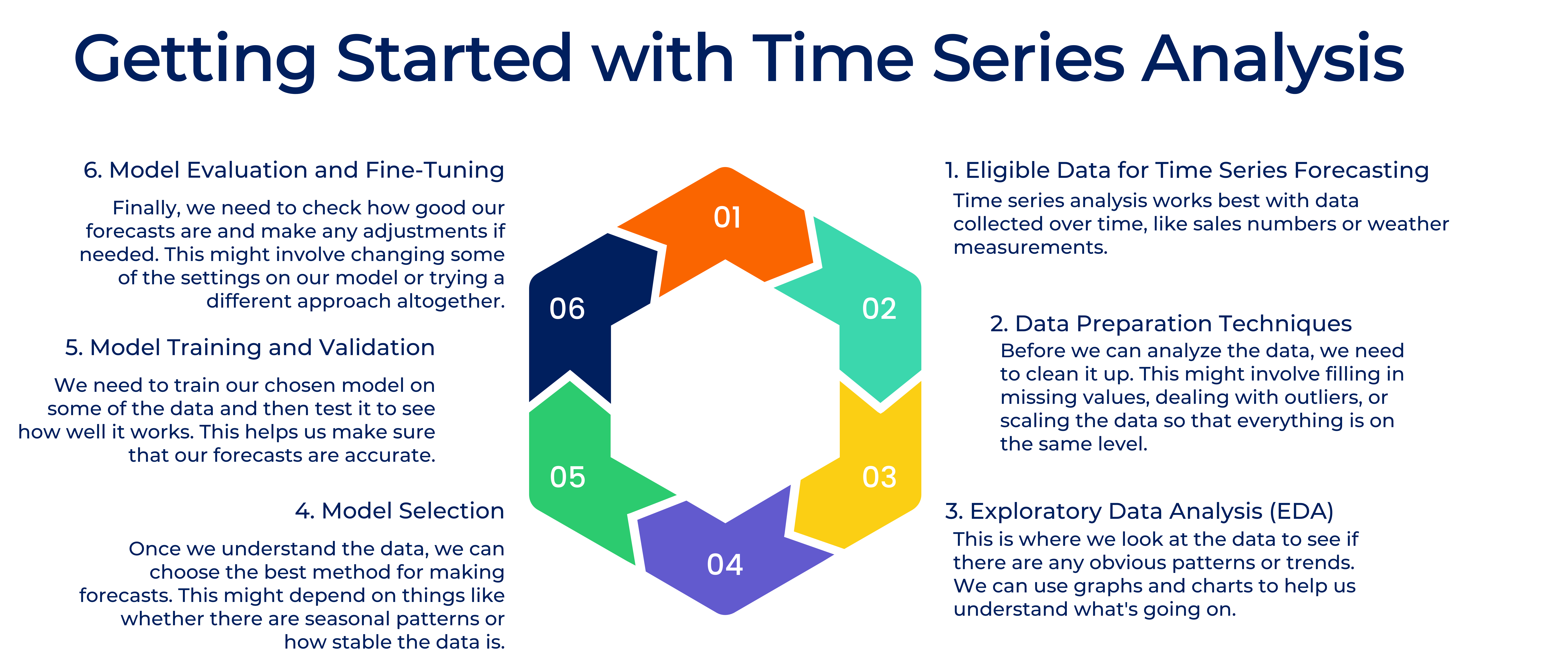Time Series Analysis: A Guide to Strategic Business Forecasting

Category :Data Analytics
Published on: 08-03-2024
In today's business world, using time series analysis is like having a secret weapon. It helps companies make smart decisions and plan. Let's take a closer look at what time series analysis is and why it's so important for forecasting in business.
Understanding Time Series Analysis
Time series analysis is all about looking at data collected over time to find patterns and trends. For example, think about tracking sales numbers each month or monitoring stock prices every day. Time series analysis helps us understand what's going on behind these numbers.
Key Concepts in Time Series Analysis
1.Components of Time Series
Trend: This is the overall direction that the data is moving in over time.
Seasonality: These are patterns that repeat at regular intervals, like every week or every year.
Cyclic Patterns: Cyclic patterns in time series are long-term fluctuations influenced by economic conditions, lacking fixed intervals, and lasting years or decades. The cyclic variation may be regular are not periodic.
Irregular Fluctuations: These are random changes in the data that don't fit into any of the other categories.
2.Stationarity
Time series data needs to be stable for accurate analysis. This means that the average and variation in the data should stay consistent over time. We can use techniques like differencing to make the data more stable.
3.Autocorrelation
This is about how each data point is related to the ones that came before it. It helps us see if there's a pattern or trend in the data.
Forecasting Methods
1.Moving Average (MA) and Exponential Smoothing
These methods are simple yet effective for forecasting.
Moving Average (MA): It calculates the average of a specified number of recent data points to predict future values. By focusing on recent data, it provides a smooth estimate of the underlying trend.
Exponential SmoothingThis method gives more weight to recent observations while exponentially decreasing the weight of older observations. It's particularly useful for capturing short-term fluctuations and is adaptable to changing trends over time.
2.Autoregressive Integrated Moving Average (ARIMA)
ARIMA is a comprehensive method that combines three key components - autoregression, differencing, and moving average - to forecast future values.
Autoregression: It predicts future values by analysing and modelling the relationship between current and past values of the variable being forecasted using a linear combination of autoregressive parameters and an error term.
Differencing: This process transforms non-stationary time series data into stationary data by computing the difference between consecutive observations.
Moving Average: It accounts for random fluctuations in the data by averaging out noise over time.
3.Seasonal ARIMA (SARIMA) and Seasonal Decomposition of Time Series (STL)
These techniques are extensions of ARIMA tailored to handle seasonal patterns.
Seasonal ARIMA (SARIMA): It extends ARIMA by incorporating seasonal factors into the model. SARIMA considers seasonal trends in addition to the non-seasonal components, enabling more accurate forecasting for data with predictable seasonal variations.
Seasonal Decomposition of Time Series (STL): STL decomposes the time series into seasonal, trend, and residual components. By separating these elements, it allows for a clearer understanding of the underlying patterns and facilitates more precise forecasting.
Advanced Techniques
1.Seasonal Exponential Smoothing (ETS)
ETS is an advanced forecasting method that combines exponential smoothing with seasonality.
Exponential Smoothing: Similar to the basic exponential smoothing method, ETS gives more weight to recent observations. However, it also incorporates seasonal patterns into the smoothing process, making it suitable for data with both trend and seasonal components.
2.Prophet
Prophet is an advanced forecasting tool developed by Facebook that excels in handling complex patterns like holidays and unusual events.Prophet utilizes a decomposable time series model with separate components for trend, seasonality, and holidays. It automatically detects patterns and adjusts forecasts accordingly, making it robust against irregularities in the data.
3.Long Short-Term Memory (LSTM)
LSTM is a sophisticated artificial intelligence technique designed specifically for analysing sequences of data, such as time series.LSTM networks can capture long-term dependencies in sequential data by maintaining a memory of past observations. This makes them well-suited for forecasting tasks where historical context plays a crucial role in predicting future outcomes.

Time series analysis is a valuable tool for businesses in many ways
1.Demand Forecasting in Retail It helps stores predict how much of a product they'll need, so they don't run out or have too much left over.
2.Energy Consumption Forecasting: Utility companies use it to plan for how much energy people will use, so they can make sure there's enough to go around.
3.Financial Market Prediction: Banks and investors use it to guess what might happen to things like stock prices, so they can make smart decisions about where to put their money.
Embracing the Power of Time Series Analysis
In conclusion, time series analysis is a powerful tool for businesses. By understanding the basics and using the right techniques, companies can make better forecasts and plan with confidence.
Tags
- TimeSeriesAnalysis
- BusinessForecasting
- TrendAnalysis
- DemandForecasting
- ARIMA
- SARIMA
- LSTM
- MovingAverage
- In22labs
- PowerBI
- Data Analytics
- e-governance
- 0
- 0
You May Also Like

15-03-2024

04-03-2024

12-02-2024

Big Data Processing with Apache Spark — the last journey through a fragmented data world
Data Analytics
12-01-2024

05-01-2024

10-02-2024

24-01-2024














